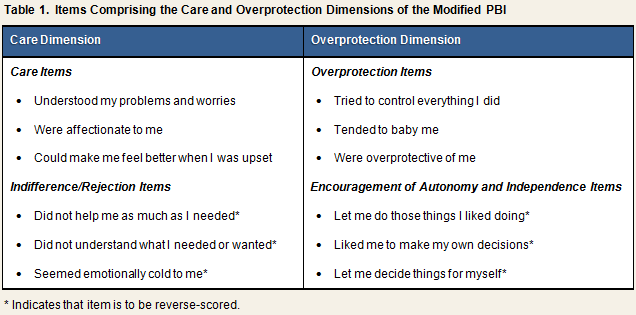Parental Bonding
Title
Modified Parental Bonding Instrument (PBI)Study
PCS3Copyright Information
Not a copyrighted scalePrimary Reference
Parker, G., Tupling, H., & Brown, L. B. (1979). A parental bonding instrument. British Journal of Medical Psychology, 52, 1-10.Type of Measure
Modified. The modified version of the PBI that was administered in PCS3 contains 12 of the 25 items that comprise the original scale. Included items were chosen based on results of a factor analysis that was published in the source article (Parker et al., 1979).Purpose
To assess via retrospective self-report two components of the parent-child relationship: demonstrations of caring (by the parent) and parental overprotection. Optimal bonding is thought to be characterized by high levels of caring and low overprotection.Description
Using a 4-point rating scale, respondents indicate the degree to which a series of phrases describing parental behaviors are like those enacted by their own parents while they were children. The time frame used is “During the first 15 years of my life.” The scale contains equal numbers of positively and negatively phrased items, with the latter being reversed so that higher total scores for each dimension reflect more of the relevant construct (see Table 1).
Scaling
1 = Very Like, 2 = Moderately Like, 3 = Moderately Unlike, 4 = Very UnlikeNumber of Items
12 (6 items each for Care and Overprotection dimensions)Psychometrics
Internal Consistency in PCS3 (n = 213)
- Care Dimension, Cronbach’s α = 0.89
- Overprotection Dimension, Cronbach’s α = 0.68
- Scale, Cronbach’s α = 0.81
Scoring/Variables
Reversed items: 1, 2, 3, 6, 9, 10Care Dimension: sum items 1R, 3R, 4, 5, 9R, 11
Overprotection Dimension: sum items 2R, 6R, 7, 8, 10R, 12
Total Bonding (higher values indicate optimal bonding): sum of Care Dimension score and Reversed Overprotection Dimension score